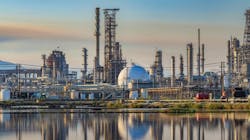Marathon Petroleum on track for Martinez refinery-to-renewables conversion
Marathon Petroleum Corp. (MPC) is progressing with its project to strategically reposition its now-idled Martinez refinery in northern California’s San Francisco Bay area into a renewable fuels production site (OGJ Online, Aug. 3, 2020).
Following the Bay Area Air Quality Management District’s (BAAQMD) recent preliminary approval of the site’s air quality permit, the first phase of the Martinez Renewable Fuels (MRF) project—which, once operable, would bring nearly 50,000 b/d [260 million gal/year] of renewable diesel supply into the market—is currently targeted for mechanical completion by yearend 2022, Mike Hennigan, MPC’s chief executive officer, told investors in the company’s latest quarterly earnings call on Aug. 2.
“We also expect to be able to close our [proposed] joint venture (JV) with Neste Corp. [as a partner at Martinez] in the coming months,” Hennigan said.
With proposed pretreatment unit (PTU) capabilities at Martinez anticipated for startup during second-half 2023, MPC—which agreed to a 50-50 JV partnership on the $1.2-billion MRF with Neste in March 2022—said it currently expects the refinery to reach full nameplate production capacity of 730 million gal/year by yearend 2023 (OGJ Online, Mar. 7, 2022).
Timelines for achieving MRF’s proposed production capacities and closing the Neste JV, however, still depend on when MPC obtains a final air quality permit for the project, Hennigan said.
MPC’s announcement follows a July 22 public notice by BAAQMD—the local agency that regulates stationary sources of industrial air pollution—of its preliminary determination that the MRF will comply with all local, state, and federal air quality-related regulations, including health risks resulting from toxic air contaminant emissions, according to an official agency release.
Based on its intensive review of the MRF permit application, BAAQMD’s preliminary recommendation to issue a final permit for the project remains subject to a 30-day public comment period on the draft air permit that runs through Aug. 23, BAAQMD said.
“[W]hen that public comment period ends, [BAAQMD], along with [MPC] providing input, will respond to any comments, and that should be the end [of the permitting process],” said Ray Brooks, MPC’s executive vice-president of refining.
“[G]etting the air permit will be a big deal that allows us to…start the unit up when it's ready, and it also allows us to close our JV partnership with Neste. So we see the light at the end of the tunnel coming,” Brooks said.
MPC also confirmed it continues to make progress on its ongoing South Texas Asset Repositioning (STAR) program at the 593,000-b/d Galveston Bay refinery in Texas City, Tex., which has included works to further integrate the operator’s former Texas City refinery into the adjacent Galveston Bay refinery to improve the site’s efficiency and reliability by increasing residual oil processing capabilities, upgrading the crude unit, and integrating logistics (OGJ Online, July 30, 2018).
Currently scheduled for completion in early 2023, the STAR project is projected to increase crude capacity at Galveston Bay by 40,000 b/d, Maryann Mannen, MPC’s executive vice-president and chief financial officer, said during the earnings call.
MRF background
After indicating its interest in evaluating the potential repositioning of the Martinez site into a renewable diesel plant following the former 161,000-b/d refinery’s permanent idling in August 2020, MPC formally filed an application in November 2020 with California’s Contra Costa County (CCC) for a land use permit to advance the MRF refinery-to-renewables conversion project.
Approved to proceed with construction by CCC’s board of directors in May 2022, the MRF proposes adding new units and removing existing but obsolete units at the site to enable processing of a mix of renewable feedstocks such as soybean oil, corn oil, rendered fats, and other miscellaneous bio-based feedstocks—including used cooking oils and other vegetable oils—into renewable diesel, naphtha, propane, and treated fuel gas (OGJ Online, June 6, 2022).
MPC would, following minor modifications, continue to use two of its existing marine oil terminals to receive and distribute renewable feedstock and fuels produced as part of the MRF, as well as begin using another MPC-owned terminal nearby. Current truck systems also would remain in use for transportation of MFR’s feedstocks and finished products, while existing pipelines would undergo minor upgrades such as insulation to ensure product remains fluid enough to flow, according to the project’s EIR. Renewable feedstocks also would be supplied via rail into regional third-party terminals but offloaded onto barges or other waterborne vessels for delivery via one of MPC’s existing marine terminals, as the refinery is not equipped to unload raw, renewable resources from trains.
Proposed unit additions at the site would include a renewable feedstock PTU, wastewater treatment equipment, and an advanced three-stage low-nitrogen oxide thermal oxidizer. Major equipment scheduled to be removed includes a crude unit, gasoline hydrotreater, alkylation unit, fluidized catalytic cracking unit (FCCU), reformers, delayed coker, steam boilers, among others.
Scheduled for a construction period of about 22 months, MPC said the first of the refinery’s existing units to be modified for the MFR’s production of renewable fuels include conversions of the No. 3 hydrodesulfurizer, the second-stage hydrocracking unit, and the No. 5 gas plant.
About the Author
Robert Brelsford
Downstream Editor
Robert Brelsford joined Oil & Gas Journal in October 2013 as downstream technology editor after 8 years as a crude oil price and news reporter on spot crude transactions at the US Gulf Coast, West Coast, Canadian, and Latin American markets. He holds a BA (2000) in English from Rice University and an MS (2003) in education and social policy from Northwestern University.

